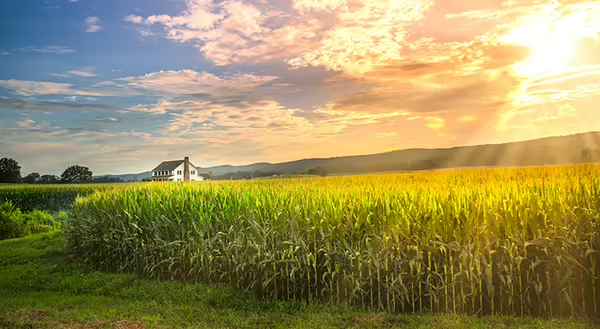
The 2025 Illinois Land Values and Lease Trends report is a must-read for anyone involved in agriculture. This year's report uncovers fascinating shifts in farmland values and lease trends across the state. What factors are driving these changes? How are different regions adapting to new economic realities? This two-part blog series post will examine the report and the dynamics shaping the agricultural landscape. Part one will cover some of the major points in the report, including overall trends in farmland values, factors influencing land sales, changes in the use of different leasing arrangements, and expectations for farmland values in the future. Understanding this report and its information can help farmers and landowners navigate the current economic challenges facing agriculture.
One of the key things to understand before diving deeper into the report is how farmland is categorized. In Illinois, farmland is classified using the soil productivity index, commonly referred to as soil PI. Illinois has hundreds of soil types across the state, each with its own unique characteristics that can impact crop yields. Two bulletins were published by the University of Illinois in August 2000 detailing each known soil type across the state: Bulletins 810 and 811. Each bulletin contains a table listing each known soil type, the expected yield per bushel for corn, soybeans, wheat, oats, sorghum, alfalfa, and other grass legumes. The tables in both bulletins were revised in 2012 with new crop yield data. Soil PI ranges from 1-147, with 147 being the highest value. The classification used by the Illinois Society of Professional Farm Managers and Rural Appraisers (ISPMFRA) is:
- Recreational Land
- Fair Productivity or “Class D” (PI between 1-87),
- Average Productivity or “Class C” (PI between 88-106),
- Good Productivity or “Class B” (PI between 107-126),
- Excellent Productivity or “Class A” (PI between 127-147).
The Land Values Report includes results from a survey of members of ISPFMRA on their expectations for farmland values in 2025. When asked what their expectations were, 49% of surveyed members expected farmland values to decrease by up to five percent in 2025, 31% expected values to stay the same, and 13% expected values to decrease between five and ten percent. Only five percent of members expected an increase in farmland values in 2025. These results were almost identical to the 2024 Land Values Report, which reported 49% of members expecting an up to five percent decrease, 32% expecting values to stay the same, and 13% expecting a five to ten percent decrease.
Respondents were asked what factors they believed would most impact farmland values in 2025. Regarding the overall health of the agricultural economy, 93% of members expected the farm economy to contract modestly in 2025, similar to the results from 2024. Additionally, half of the members expected interest rates to stay about the same, while 43% expected a decrease in interest rates. A significant portion of members (60%) expected corn prices to be less than $4.50 per bushel, and 38% expected the price to be between $4.50 and $5.50 per bushel. A further 53% of members expected production costs to remain the same in 2025, with 36% expecting a decrease and 21% expecting an increase in production costs.
Members were also asked about the characteristics of both sellers and buyers of farmland from 2024. The members reported that 59% of the sellers in 2024 were estates, with 13% of sellers being retired farmers and 12% being individual investors. Only six percent of the sellers in 2024 were active farmers. As for the reason for selling, 57% of the sales were to settle estates, with 13% to re-invest in other ag enterprises and 12% to invest in non-ag assets. 53% of the farmland sold in 2024 was sold through a public auction, with 27% sold in a private treaty sale and 17% in a multi-parcel auction. Most farmland buyers in 2024 (57%) were local farmers, 17% were local investors, and 13% were non-local investors.
Members of ISPFMRA were also surveyed on the cash rent rates for land they managed in 2025 and the expectations for cash rents for 2026. The range of cash rents for excellent farmland in 2025 was between $315 and $404 per acre, down from the 2024 range of $350 and $425 per acre in 2024. The range for average farmland in 2025 was between $260 and $342 per acre, also down from the 2024 range of $283 and $355 per acre. It is also important to note that there has been a decreasing trend in cash rents since 2022. When asked the type of lease agreements used for 2025, 41% of members reported using a traditional cash rent agreement, 26% using a variable cash rent agreement, and 21% using a traditional crop share agreement. Members were also asked about their beliefs about cash rent rates for the 2026 crop year. Half of the members expected 2026 cash rents to be the same as 2025, with the other half expecting a decrease in 2026, and none expecting an increase in 2026.
This blog post was the first of a two-part series examining the 2025 Land Values Report published by the Illinois Society of Farm Managers and Rural Appraisers. This report uses data from land sales in 2024, combined with surveys of Society members, to paint a picture of the farmland market and values across Illinois. This post explained how soils and farmland is classified in Illinois, the factors impacting farmland values, and expectations for farmland values in 2025 and beyond. The second part of this series will dive deeper into the report by looking at the values for some of the regions across Central Illinois.
For further reading, visit the following links:
- Bulletins 810 and 811: http://soilproductivity.nres.illinois.edu/.
- 2025 ISPFMRA Land Values Report: https://ispfmra.org/2025/03/27/download-now-our-2025-land-values-lease-trends-report/.